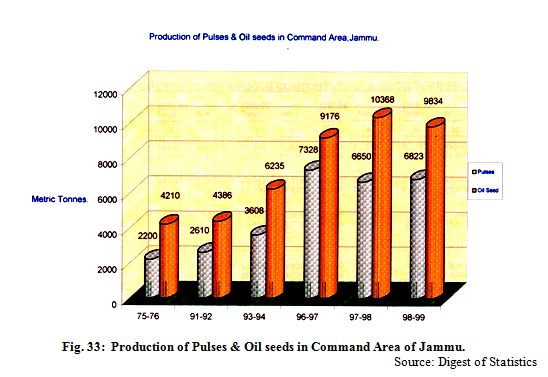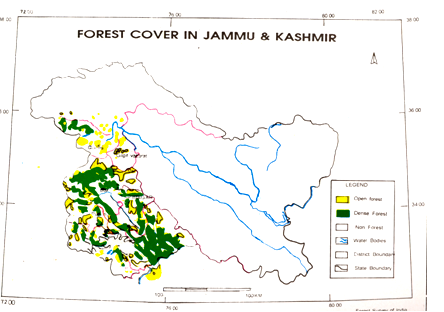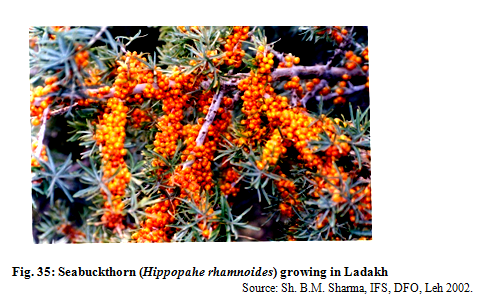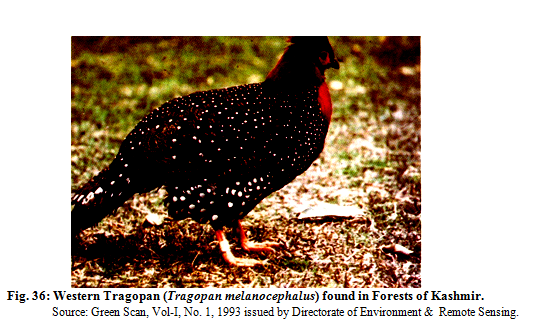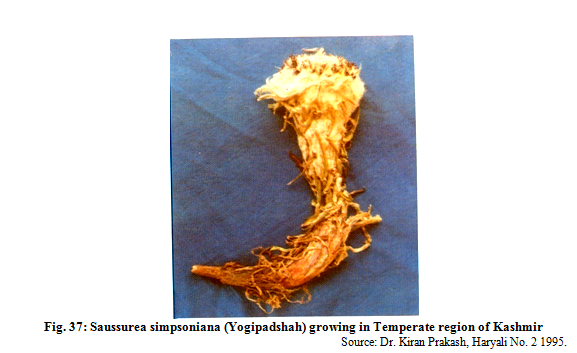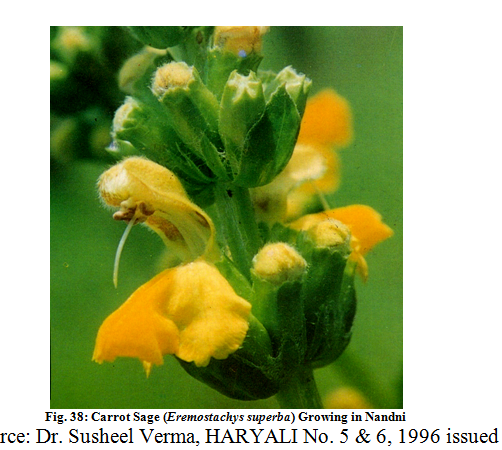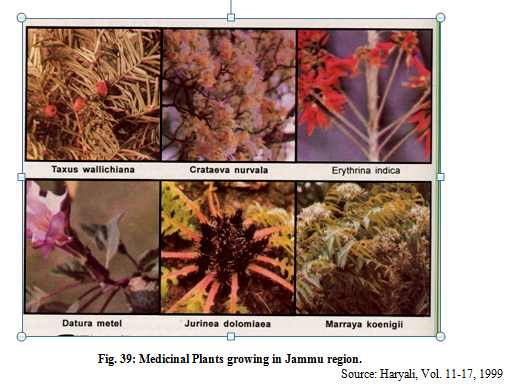Bio-diversity In Jammu, Kashmir, Ladakh: Ecological Profile
This article has been sourced from an authoritative, official readers who wish to update or add further details can do so on a ‘Part II’ of this article. |
Contents |
The source of this article
Bio-diversity in Jammu, Kashmir, Ladakh
By the Department of Forests, Government of Jammu and Kashmir
Cropland ecosystem
Agriculture and allied activities constitute the main occupation of people living in Jammu & Kashmir. About 60% of the population is directly or indirectly dependent on Cropland Ecosystem. The state reflects uniqueness in terms of hill and valley area agriculture, aquaculture, horticulture, sheep rearing and animal husbandry, carpet weaving, embroidery and handicrafts. Agriculture and animal husbandry including sheep rearing is practiced from the sub-tropical belt of Jammu to the cold-desert zone of Ladakh. The area under crop cultivation in the state is about 9.7 lakh hectares and the pastureland extends to 1.3 lakh hectares. The Kashmir region is a large valley with natural springs, streams, lakes, pastures and orchards. Here cultivation and domestication of various plant and animal varieties is unique. Many of the forms are peculiar to the region and are world famous.
The main agricultural crops of J&K are paddy, maize, wheat, oil seeds, pulses, vegetables and fruits. Paddy and maize are the two major kharif crops, whereas wheat and oilseed are major rabi crops. Total area under paddy cultivation has increased from 2,65,000 ha in 1985 to over 2,75,000 ha. Important rice growing areas are Anantnag, R.S. Pura and Bhaderwah. The oilseeds include Mustard, Sesame, Linseed and Alsi. Total area under oil seeds in the state was 64000 hectares in 1994-95 which got increased to 75000 ha in 1999-2000. The pulses grown in the state are Urd, Moong, Raungi, Rajmash and Kulth. The area under pulses was 55000 ha in 1968-69 but was decreased to 29000 ha. in 1999-2000.
Horticulture and Animal husbandry are other important allied activities of the agricultural sector and are very important to the Economy of J&K. Major fruits cultivated in J&K are Apple, Apricot, Cherry, Walnut, Quince, Amlook, Peach, Plum and Citrus. In the animal husbandry sector, Cows, Buffaloes, Goats, Sheep, Camels, Pigs, Poultry and Yak are domesticated.
In Jammu division wild stocks of various cultivars like Ber, Kainth, Amla, Peach, Olive, etc. are found growing. Keeping in view the economical importance of these cultivals efforts are already going on for utilizing these stocks for further improvement in the Horticulture sector. In order to boost the fruit industry in Jammu province, the cultivation of various fruit cultivars on modern and scientific lines is already in progress. The fruits under cultivation are Mango, Guava, Grapes, Litchi, Citrus, Walnut, Almond, Apple, Peach, Plum, Apricot and Peacannut. In addition to these, cultivars of Strawberry, Olive and Kiwi are also gaining popularity. Under area expansion programme department of Horticulture has covered an area of 2,19,039 ha. in respect of dry and fresh fruits by the end of 2000-01. The major cultivars grown in sub-tropical region of Jammu, Udhampur, Kathua and Rajouri are :
1) Ber Cultivars : Umaran, Samar No. 2, Katheli.
2) Mango Cultivars : Dusheri-51, Amarpali, Langra, Malda, Ratna.
3) Citrus Cultivars : Kinnow, Malta, Mausami, Sangtra, Sweetlime, Kagzi lime
Eurica lemon, Galgal, Kimb.
4) Lichi Cultivars : Dehradun, Calcuttia, Seed less.
5) Guava Cultivars : Lalit, Allahbad Safeda, L-49.
In temperate zone of Jammu province following cultivars of fruits are under cultivation: 1) Grape cultivars : Loose, Perlette, Thomson seedless, Shashi, Beauty
seedless.
2) Walnut cultivars : Medium shelled and Thin shelled.
3) Apple cultivars : Delicious, Ambri, Kesri, Maharaji,
4) Pear cultivars : Baghugosha, Nakh.
5) Peach cultivars : Shan-e-Punjab, Florda-sun, Sharbati,
6) Plum cultivars : Frontier, William, Santarosa,
7) Appricot cultivars : Webcom, Harkat, Amba
8) Pecannut cultivars : Mohan, Nalif.
9) Strawberry cultivar : Chandler, Duglas, Confutura.
10) Olive cultivar : European olive.
11) Kiwi cultivars : Allison, Abbott, Bruno, Hayward
The popularity of Kashmiri Apple, Walnut and Almond is growing all over the country. The snow kissed apple grown in valley is famous. Ambri cultivar is indigenous and is grown in South-Kashmir particularly in Shopian belt. The most promising varieties of pear grown in Kashmir are Sandy pear (Kashmiri Nakh), William pear (Baghugosha). The other indigenous varieties found in Kashmir are Kotar Nakh, Khar Paddar and Zirhami Pear (growing in Ganderbal). Grape varieties growing in Northern-Kashmir are Raipora and Lar in Ganderbal tehsil. Some indigenous varieties are Hussaini and Sahibi which are resistant to powedry mildews and downy mildews,
Sericulture is another allied activity which has developed over the years and now cocoon production has reached a new high of 8900 qtls. which was merely 3000 qtls in 1974-75. Number of sericulture villages is 2166 in the state. Production of raw silk is 21000 kgs. having a value of Rs. 2,60,000 lacs
Microlevel characteristics of agricultural landscape vary from place to place and due to these variations, different soils are able to support a wide range of plant and animal varieties. The Suru valley of Ladakh is watered by streams from the surrounding lofty mountain peaks and produce rich crops of wheat and barley. Traditionally, it has been an area surplus in food grains. Due to availability of water for irrigation, this area stands out in the otherwise desolate and barren landscape of Ladakh. There are good stands of willow and poplar and provide the landscape a lush green look which is rare in Ladakh. Down the river Indus, between Khaltse and Shyok Indus confluence, Drokpa community inhabits Dah & Biama villages. They grow various kinds of fruits like apricots, apples, walnuts and grapes. Cultivation of winter cherry is unique to the area. Red colored fruits of this plant are employed to decorate the head-dress. The ground floor in the suru-valley is covered with dense thickets of Sea-buckthorn which the locals use for fuel and fence purposes.
In the Nubra valley, down the river Shyok, to Hundar, a small population of Double-Humped Bactrian camels is found existing. In the olden days, they were introduced through the famous silk route as pack animals. During the past 50-60 years, they have been employed for the transportation purposes in the Nubra Valley. The valley is lush green along the water courses Major ground cover is formed by the Seabuck thorn, Myricaria, Lycium and Lonicera.
The Payong-gong lake is a unique water body which provides a spectacular view to the tourists. Reflections of the surrounding mountain peaks in the blues and greens of lake’s brackish water is a spectacle to be admired by all. Near this lake a scanty population of Chan-Panomads is seen. They cultivate peas, barleys in summer and during winter they unfold their tents (rebo) and take their flock of Sheep and pashmina goats out in the distant pastures. In Rupshu area, Korzok village situated at 4572 m above sea level forms the only permanent settlement. The local nomads called Chang-pa live in tents all the year round and move between pastures existing near snow melt streams. Few barley fields at Karzok are among the highest cultivated areas in the world but due to inhospitable climate, there is no guarantee that crop will ripen each year. Rupshu valley supports a sparse population of Wild Ass locally known by the name, Kyang. Various alpine lakes are breeding grounds for various birds like barheaded goose, Great Crested Grebe, Black necked cranes, Brahminy Duck and Brown Headed Gull.
The valley of Kashmir is famous for its fruit orchards and saffron cultivation. Fruit growing and saffron cultivation provides employment to more than 5 lakh families.
The climate is of Mediterranean type which is more suited to cultivation of different horticultural crops. Besides 90 private Nurseries, state Government has also established a good network of nurseries to provide the quality saplings to the fruit growers. More than 2000 sq. km. Area is under Fruit orchards. The annual production of fruits is tabulated as under:
Table 19: The District wise production of main fruits in Jammu & Kashmir for the year 1999-2000.
Department of Horticulture (Production in Metric Tonnes)
|
S. No |
Kind of fruit |
Srinagar |
Budgam |
Baramulla |
Kupwara |
Anantnag |
Pulwama |
Total |
Leh |
Kargil |
Total |
Jammu |
Kathua |
Poonch |
Rajouri |
Doda |
Udha-mpur |
Total |
Total |
|||||||||||||||||||||||||||||||||||||||||||||||||||||||||||||||||||||||||||||||||||||||||||||||||||||||||||||||||||||||||||||||||||
FRESH FRUITS |
|
|
|
|
|
|
|
|
|
|
|
|
|
|
|
|
|
|||||||||||||||||||||||||||||||||||||||||||||||||||||||||||||||||||||||||||||||||||||||||||||||||||||||||||||||||||||||||||||||||||||
|
1. |
Apple |
25506 |
39943 |
522091 |
69219 |
158397 |
100707 |
915863 |
3238 |
294 |
3532 |
0 |
1100 |
3815 |
288 |
2251 |
2173 |
9627 |
929022 |
|||||||||||||||||||||||||||||||||||||||||||||||||||||||||||||||||||||||||||||||||||||||||||||||||||||||||||||||||||||||||||||||||||
|
2. |
Pear |
2461 |
3592 |
2051 |
3304 |
2732 |
2345 |
16485 |
6 |
4 |
10 |
0 |
2500 |
6750 |
1050 |
1144 |
1302 |
12746 |
29241 |
|||||||||||||||||||||||||||||||||||||||||||||||||||||||||||||||||||||||||||||||||||||||||||||||||||||||||||||||||||||||||||||||||||
|
3. |
Apricot |
268 |
213 |
1056 |
45 |
233 |
250 |
2065 |
2541 |
1153 |
3694 |
0 |
40 |
30 |
55 |
561 |
159 |
845 |
6604 |
|||||||||||||||||||||||||||||||||||||||||||||||||||||||||||||||||||||||||||||||||||||||||||||||||||||||||||||||||||||||||||||||||||
|
4. |
Peach |
95 |
20 |
107 |
51 |
57 |
9 |
339 |
6 |
3 |
9 |
28 |
350 |
415 |
88 |
29 |
181 |
1091 |
1439 |
|||||||||||||||||||||||||||||||||||||||||||||||||||||||||||||||||||||||||||||||||||||||||||||||||||||||||||||||||||||||||||||||||||
|
5. |
Plum |
1028 |
482 |
0 |
62 |
209 |
198 |
1979 |
0 |
0 |
0 |
0 |
65 |
1556 |
120 |
32 |
104 |
1877 |
3856 |
|||||||||||||||||||||||||||||||||||||||||||||||||||||||||||||||||||||||||||||||||||||||||||||||||||||||||||||||||||||||||||||||||||
|
6. |
Cherry |
3170 |
152 |
481 |
368 |
419 |
714 |
5304 |
0 |
9 |
9 |
0 |
0 |
0 |
0 |
2 |
1 |
3 |
5316 |
|||||||||||||||||||||||||||||||||||||||||||||||||||||||||||||||||||||||||||||||||||||||||||||||||||||||||||||||||||||||||||||||||||
|
7. |
Mango |
0 |
0 |
0 |
0 |
0 |
0 |
0 |
0 |
0 |
0 |
5582 |
3140 |
0 |
908 |
0 |
921 |
10551 |
10551 |
|||||||||||||||||||||||||||||||||||||||||||||||||||||||||||||||||||||||||||||||||||||||||||||||||||||||||||||||||||||||||||||||||||
|
8. |
Ber |
0 |
0 |
0 |
0 |
0 |
|
0 |
0 |
0 |
0 |
8010 |
21 |
0 |
600 |
0 |
341 |
8972 |
8972 |
|||||||||||||||||||||||||||||||||||||||||||||||||||||||||||||||||||||||||||||||||||||||||||||||||||||||||||||||||||||||||||||||||||
|
9. |
Grapes |
1234 |
5 |
22 |
0 |
0 |
0 |
1261 |
8 |
3 |
11 |
178 |
5 |
1 |
0 |
0 |
19 |
203 |
1475 |
|||||||||||||||||||||||||||||||||||||||||||||||||||||||||||||||||||||||||||||||||||||||||||||||||||||||||||||||||||||||||||||||||||
|
10. |
Citrus |
0 |
0 |
0 |
0 |
0 |
0 |
0 |
0 |
0 |
0 |
3843 |
5283 |
153 |
1240 |
142 |
2635 |
13296 |
13296 |
|||||||||||||||||||||||||||||||||||||||||||||||||||||||||||||||||||||||||||||||||||||||||||||||||||||||||||||||||||||||||||||||||||
|
11. |
Olive |
0 |
0 |
0 |
0 |
0 |
0 |
0 |
0 |
0 |
0 |
0 |
0 |
0 |
0 |
1 |
1 |
2 |
2 |
|||||||||||||||||||||||||||||||||||||||||||||||||||||||||||||||||||||||||||||||||||||||||||||||||||||||||||||||||||||||||||||||||||
|
12. |
Other fresh |
1001 |
62 |
1354 |
524 |
47 |
0 |
2988 |
0 |
0 |
0 |
3916 |
678 |
306 |
1042 |
190 |
2112 |
8244 |
11232 |
|||||||||||||||||||||||||||||||||||||||||||||||||||||||||||||||||||||||||||||||||||||||||||||||||||||||||||||||||||||||||||||||||||
|
Total fresh |
34763 |
44469 |
527162 |
73573 |
162094 |
104223 |
946284 |
5799 |
1466 |
7265 |
21557 |
13182 |
13026 |
5391 |
4352 |
9949 |
67457 |
1021006 |
||||||||||||||||||||||||||||||||||||||||||||||||||||||||||||||||||||||||||||||||||||||||||||||||||||||||||||||||||||||||||||||||||||
DRY FRUITS |
|
|
|
|
|
|
|
|
|
|
|
|
|
|
|
|
|
|||||||||||||||||||||||||||||||||||||||||||||||||||||||||||||||||||||||||||||||||||||||||||||||||||||||||||||||||||||||||||||||||||||
|
1. |
Walnut |
1994 |
6071 |
7479 |
5473 |
22869 |
13722 |
57608 |
101 |
10 |
111 |
0 |
4000 |
5730 |
900 |
4061 |
2496 |
17187 |
74906 |
|||||||||||||||||||||||||||||||||||||||||||||||||||||||||||||||||||||||||||||||||||||||||||||||||||||||||||||||||||||||||||||||||||
|
2. |
Almond |
141 |
1909 |
9 |
0 |
124 |
7480 |
9663 |
1 |
0 |
1 |
0 |
1 |
0 |
1 |
2 |
4 |
8 |
9672 |
|||||||||||||||||||||||||||||||||||||||||||||||||||||||||||||||||||||||||||||||||||||||||||||||||||||||||||||||||||||||||||||||||||
|
3. |
Other dry |
144 |
0 |
0 |
0 |
0 |
0 |
144 |
0 |
0 |
0 |
0 |
0 |
2 |
41 |
0 |
2 |
45 |
189 |
|||||||||||||||||||||||||||||||||||||||||||||||||||||||||||||||||||||||||||||||||||||||||||||||||||||||||||||||||||||||||||||||||||
|
Total dry |
2279 |
7980 |
7488 |
5473 |
22993 |
21202 |
67415 |
102 |
10 |
112 |
0 |
4001 |
5732 |
942 |
4063 |
2502 |
17240 |
84767 |
||||||||||||||||||||||||||||||||||||||||||||||||||||||||||||||||||||||||||||||||||||||||||||||||||||||||||||||||||||||||||||||||||||
|
Grand Total |
37042 |
52449 |
534650 |
79046 |
185087 |
125425 |
1013699 |
5901 |
1476 |
7377 |
21557 |
17183 |
||||||||||||||||||||||||||||||||||||||||||||||||||||||||||||||||||||||||||||||||||||||||||||||||||||||||||||||||||||||||||||||||||||||||||
|
District |
Rice |
Maize |
Wheat |
Pulses |
Oilseeds |
|||||
|
Area (000ha) |
Prod. (000 qtsl) |
Area (000ha) |
Prod. (000 qtsl) |
Area (000ha) |
Prod. (000 qtsl) |
Area (000ha) |
Prod. (000 qtsl) |
Area (000ha) |
Prod. (000 qtls) |
|
|
Anantnag |
37.58 |
2278 |
25.69 |
1020 |
- |
16 |
1.15 |
53 |
24.06 |
- |
|
Pulwama |
23.33 |
11.58 |
0.53 |
1.69 |
19.42 |
|||||
|
Srinagar |
12.02 |
4.70 |
- |
0.62 |
2.23 |
|||||
|
Budgam |
24.91 |
16.32 |
0.42 |
0.85 |
5.39 |
|||||
|
Baramulla |
27.19 |
32.44 |
0.47 |
4.71 |
3.26 |
|||||
|
Kupwara |
11.25 |
24.10 |
0.13 |
1.78 |
2.58 |
|||||
|
Leh |
- |
- |
- |
- |
2.55 |
36 |
0.26 |
6 |
0.07 |
- |
|
Kargil |
- |
- |
1.61 |
0.64 |
- |
|||||
|
Jammu |
50.16 |
1875 |
20.99 |
4238 |
101.05 |
1435 |
5.91 |
69 |
2.78 |
- |
|
Udhampur |
9.80 |
57.70 |
41.55 |
2.48 |
2.58 |
|||||
|
Doda |
3.50 |
51.73 |
11.09 |
2.88 |
2.76 |
|||||
|
Kathua |
34.30 |
16.23 |
53.10 |
3.64 |
7.08 |
|||||
|
Rajouri |
6.42 |
45.05 |
53.83 |
0.77 |
0.36 |
|||||
|
Poonch |
3.60 |
23.68 |
14.63 |
0.07 |
1.34 |
|||||
|
Total |
244.05 |
4153 |
330.21 |
5258 |
280.96 |
1487 |
27.45 |
128 |
73.91 |
281.61 |
Source: Digest of Statistics.
18758
6333
8415
12451
84697
1105773
Source : Directorate
Rice is the major crop of the farmers and is grown over 250000 ha. Various local rice varieties like Mushkbujhee, Larbol, Nunabol, Londa, etc. are unique to this region of Kashmir. Out of annual rice production of 41,53,000 qtls. in the state, 22,78,000 qtls. is supplied by the Kashmir farmers alone (2000-01 data).
Jammu province has sub-tropical type of climate in the Kandi belt of Kathua and Jammu districts. People usually grow wheat, maize and millets in this area. Other crops grown are Rajmash, Pulses, Vegetables, Mustard, Sesame, Linseed, etc. The Command Area Development has been instrumental in changing the agricultural economy of the people by providing them the facilities of irrigation, fertilizers, improved hybrid seeds,
Table 20: Production of various crops in Command Area of Jammu
|
Crop |
1975-76 Produc-tivity Qtls. |
Prod. M.T. |
1993-94 Produc-tivity |
Prod. M.T. |
1995-96 Produc-tivity |
Prod. M.T. |
1996-97 Produc-tivity |
Prod. M.T. |
1997-98 Produc-tivity |
Prod. M.T. |
1998-99 Produc-tivity |
Prod. M.T. |
|
Paddy |
12 |
11400 |
45 |
90154 |
45 |
96750 |
38.50 |
84700 |
39.20 |
88317 |
39.20 |
86455 |
|
Maize |
15 |
31500 |
20 |
27805 |
25 |
28000 |
27.80 |
27800 |
24.00 |
26082 |
24.00 |
26250 |
|
Oil seeds |
04 |
9200 |
26 |
14868 |
08 |
16760 |
08.00 |
9176 |
08.10 |
10368 |
08.10 |
9834 |
|
Pulses |
|
|
|
|
|
|
08.00 |
7328 |
07.00 |
6650 |
07.00 |
6823 |
|
Wheat |
10 |
40000 |
33 |
144000 |
33 |
144500 |
32.00 |
152032 |
33.60 |
178712 |
35.60 |
181916 |
|
|
|
92100 |
|
276817 |
|
287010 |
|
281036 |
|
310099 |
|
311278 |
Source: Digest of Statistics.
In the Chenab valley of Doda district monsoon is poor and deficient in Doda and Kishtwar whereas Bhaderwah is comparatively moist. Major crops grown in this valley are Maize, Rice, Rajmash, etc.
In the Poonch District Gujjars and Bakerwals reside on the mountain slopes. They have small land holdings and most of them rear herds of sheep and goats. Maize, wheat and paddy are the principal crops in this region.
Forest Ecosystem
Forests of J&K extend over an area of 20182 sq. km. out of total geographical area of 222236 sq. km. The Total Forest Cover works out to be about 9%. As per National Forest Policy, 1988, J&K being the Hilly state, the forest cover of 66% is required against the prescription of 33% for plain region of the states. Whatever forests are existing, their density is also variable, about 46% of the forest cover has density between 10-40% and only the remaining forest cover has density of more than 40%.
Fig. 34: Forest Cover in J&K Source: Digest of Forest Statistics, 1996, J&K Government.
Singh & Kachroo, 1976, have identified three main vegetation types in the state: 1. Alpine desert vegetation of Ladakh.
2. Temperate vegetation of Kashmir.
3. Sub-tropical vegetation of Ladakh.
Alpine Desert Vegetation of Ladakh
Ladakh, the land of Lamas and Gompas is a trans-Himalayan high altitude cold desert with very rough physiography and wide open valleys along the rivers. The region is devoid of bryophytes and pteridophytes and even natural trees are absent. Due to scarcity of rainfall, plants are generally restricted to the river banks, moist rock surfaces and other sheltered habitats. According to Stewart, 1916, Ladakh flora has three main components, i.e. Alpine, Desertic and Oastic.
The Alpine flora is found existing along the edges of melting glaciers at an elevation exceeding 3300 m. Major plants of this component include Pedicularis, Delphiniums, Primulas, Gentianas, Lomantogonium, Saussureas, Arnebias, Rheums, etc.
The Desertic type of flora is characteristic of Ladakh and it shows distinct affinities with the plants of Tibet and Siberia. The plant forms are mostly stunted. Xerophytic and cushion like, as an adaptation to cold dry winds and blizzards. Common plant species are Caragana brevifolia, Acantholimon lycopodioides, Arenaria festucoides, Thylocospermum caespitosum, etc.
The Oasitic type of elements are restricted to mesophytic type of places. Common plants of this category comprise of Junipers, Acer, Populus, Salix, Prunus, Polygonums, Primulas, Anemones, etc.
Temperate Vegetation of Kashmir
Kashmir valley is drained by the river Jhelum and numerous snow-fed tributaries from the surrounding mountains. Many springs and streams add to the charm and beauty of flowers. The water courses and margins of streams support the luxuriant vegetation comprising of plants like Spiraeas, Impatiens, Chenopodiums, Epilobiums, Geraniums, Delphiniums, Ranunculus, Fragaria, Primulas, Polygonums, Fritillarias, Potentillas and Pedicularis species. Vegetation of lakes comprise of Lythrum salicaria, Nymphaeas, Nelumbo Trapa, Limnanthemum, Hydrillas, Utricularias, Ceratophyllum, Typhas and other grasses.
Natural vegetation stands altered by the introduction of many exotics like Poplars, Willows, Chinars, Spanish chest nut, Magnolias, Acer negonda, Ailanthus, Albizia julibrissin, Buddlejas, Hydrangeas, Philadelphus, Hypericums, Spiraeas, Phlox paniculata, Viburnum opulus and cherry laurels. Euryala ferox once common in Dal lake is seldom seen in the water bodies of Kashmir.
Dominant tree flora is composed of Pinus wallichiana, Cedrus deodara, Picea smithiana, Taxus wallichiana, Abies pindrow, Aesculus indica, Acer pictum, Parrotiopsis jacquemontiana, Carategus soongarica, Lonicera in the blue pine zone and higher up species like Salix denticulate, Skimmia laureola, Lonicera myrtilis, Berberis jaeschkeana are frequently found. Towards the upper limit, Abies pindrow, Betula utilis, Rhododendron campanulatum, Cotoneaster, Viburnum and Lonicera species form the major component of the Flora.
Alpine vegetation is comprised of elements like Aconitums, Delphiniums, Primulas, Anemones, Aquilegias, Asters, Saussureas, Corydalis, Potentillas and Pedicularis species which add colour and beauty to the summer landscape of the Kashmir mountains and meadows. Various kinds of Apollo butterflies are also a common sight. Various kinds of Nival insects alone find shelter in this zone.
Sub-tropical Vegetation of Jammu
Dry mixed deciduous type of vegetation is the major component of Flora of Jammu. The area supports three types of vegetations i.e. Scrub forests in the semi-arid tract; scrub and mixed deciduous vegetation at higher elevations and temperate vegetation in the higher hills.
Directorate of Social Forestry J&K
Scrub forests are typically dominated by plants like Acacia modesta, Dodonea viscosa, Justicia adhatoda, Caralluma tuberculata, Telosma pallida, Tribulus terrestris, Cassia occidentalis, Tephrosia purpurea, Ziziphus mauritiana, Capparis sepiaria, Woodfordia fruiticosa, Butea monosperma, Cassia fistula, Dioscorea belophylla, Delbergia sissoo, Caeseria tomentosa, Putranajiva roxburghii, etc.
Mixed deciduous vegetation of higher elevations is formed by the presence of Flacaurtia indica, Lannea coromandelica, Mallotus phillipensis, Ehretia laevis, Holarrhaena antidysentrica, Moringa oleifera, Emblica officinalis, Acacia nilotica, Ficus racemosa, Premna mucronata, Ougeinia oogeinensis, Maytenus royleanus, Terminalia bellerica, Bauhinia variegata, Bombax ceiba, Aegle marmelos, Hymenodictyon excelsum and Elaeodendron glaucum.Hill vegetation is dominated by plants like Wendlandia heynei, Grewia optiva, Pistacia integerrima, Lannea coromandelica, Pinus roxburghii, Reinwardtia indica, Oroxylum indicum, Eranthemum pulchellum, Caesalpinia decapetala, Antidesma diandrum, Mallotus phillipensis, Buddleja asiatica, Ficus roxburghii, Pyrus pashia, Rhamnus triqueter, Rubus ellipticus.
Still higher elevations in the chenab valley and Rajouri – Poonch Districts support plants like Quercus ilex, Quercus dilatata, Quercus glauca, Quercus semicarpifolia, Quercus leucotrichophora, Acer pictum, Lyonia ovalifolia, Rhododendron arboreum, Andrachne cordifolia, Fraxinus hookeriana, Machilus odoratissima, Litsea chinensis, Neolitsea pallens, Morus serrata, Ulmus villosa, Desmodium tilaefolium, Dabregeasia hypoleuca, Berberis lycium, Buddleja crispa, Indigofera gerardiana, Ehretia serrata, Symplocos paniculata, Rhus punjabensis, Prinsepia utilis, Lonicera quinquelocularis etc. Ground Flora is comprised of herbaceous plants like Boenninghausenia albiflora, Polygala crotalarioides, Sarcococa saligna, Ranunculus lactus, Potentilla nepalensis, Geum urbanum, Salvia lanata, Stachys, Prunella vulgaris, Bistorta amplexicaulis, Onychium japonicum, Pteris longifolia, Polystichum aculeatum, Mosses and lichens.
=== Forest Types=Mainly 8 types of forests are identified in Jammu and Kashmir. These are described below: